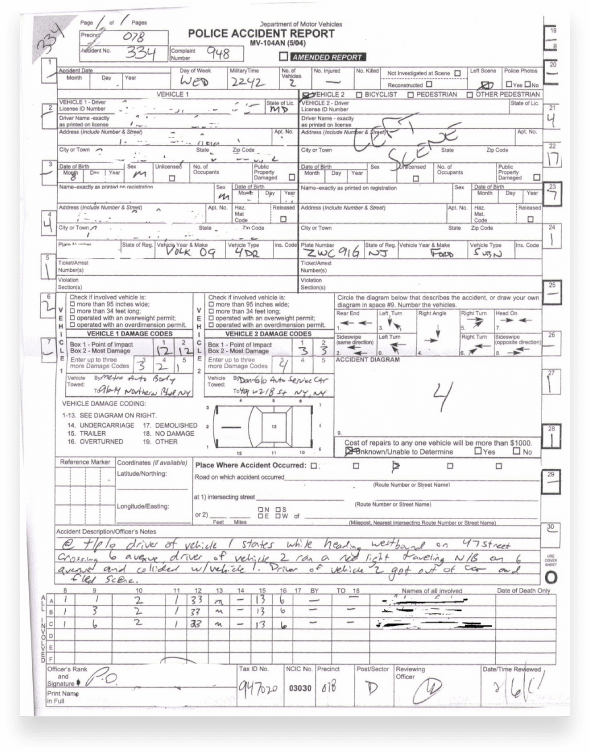What is in an Arrest Report?
 An arrest from ten years ago, revealed by the study of arrest records, could prove harmful to the campaign of Jumaane Williams, who is currently running for New York City public advocate. Courtesy of The New York Times.
An arrest from ten years ago, revealed by the study of arrest records, could prove harmful to the campaign of Jumaane Williams, who is currently running for New York City public advocate. Courtesy of The New York Times.
Public arrest reports and records are documents that detail the events leading up to and immediately after an arrest. They are largely created by law enforcement agencies to detail and document instances where police, sheriffs, or agents of law enforcement interact with the public in such a way as to deprive them of their freedom. These public criminal records are important for citizens of the United States as they explain events where someone’s rights were removed because of an infraction or breach of the law. Because of the Freedom of Information Act, Americans are able to look up arrest records for public perusal and study.
The Purpose of an Arrest Report
Knowing how to find someone’s criminal record and get information on an arrest is a critical part of understanding citizen rights and the precedents that set them. So it is equally important to understand what information is held within an arrest record, even prior to searching for the documents in question. In this way, curious citizens can know if finding and obtaining records will benefit them.
What Crime Was Committed and How
The primary goal of public police records, criminal public records, or incident documents is to document a person’s criminal history. The uses for arrest records range from evidence in court (typically the first piece) to checking someone's public criminal history for the purposes of employment or housing, simple curiosity, and more. The sections that create an arrest record are typically broken into incident information, the reporting party section, the victim section, a section for the alleged suspect, and a narrative section. The information within includes fingerprints of the offender, their photograph, criminal charges, identifying marks, aliases, social security numbers, ethnicity, height, weight, and more. Please note that because someone has an arrest record is not a guarantee that a person was convicted. Arrest records are created when a person is apprehended by law enforcement and occurs well before any trial or court action. Arrest records are also not always complete, but this is the expected information within.
 Here is an example of a police report filed for a hit-and-run incident. Note that some areas are filled in, while others are not.
Here is an example of a police report filed for a hit-and-run incident. Note that some areas are filled in, while others are not.
Sections of an Arrest Report or Police Report
The sections of a police report help detail those involved in an alleged incident, and the events that led to the incident, and the events immediately following the incident. These areas and sections are useful for understanding the nature of the alleged offense, as well as the action of police, sheriffs, or other law enforcement agents. They are usually generated by police officers or sheriff’s deputies, but can also be reported by concerned citizens, like in Snohomish County, Washington.
-
Incident area
This is the section of the arrest record that documents simple logistic information the incident location about the alleged crime. They will typically include where the alleged crime took place, the date and time where the incident occured, and what type of crime is believed to have been committed. Other ancillary information can include injuries that occurred as a result of the alleged crime, as well as other unusual factors encountered when investigating a reported incident. -
Reporting party area
This section exists to document the reporting party, or the party that filled in the police report. For policemen, sheriffs, and other agents of law enforcement, this usually means a simple badge number and name, as all information on the officer is held by the department. When a citizen makes a report, they must provide their name, address, birthday, nationality, marital status, social security number (for purposes of identification), and relationship to the alleged criminal. -
Victim area
The victim area holds the same information as the reporting party section, but details any victim of the alleged crime instead of the reporting party. It includes their full first and last name, complete address, ethnicity, birth date, relationship status, any injuries that may have occurred as a result of the alleged crime. -
Alleged criminal area
This area of the police report is focused on information about the alleged suspect. It includes information such as their full name, birthday, address, ethnicity, relationship status, and birthday, but it usually also includes a full physical description including information like hair color, build, presumed height and weight, identifying features and last known whereabouts. This is the main reason to look up an arrest record for the purposes of employment, housing, and more. -
Narrative area
The narrative area is essentially for describing the series of events that led to the arrest. From a police perspective, this is the section where they describe the reasons for their actions and any suspicions that led them to arresting or apprehending an individual. This section is very important for use in a court of law as evidence.
Offender Information in a Police Report
When apprehended, an offender will be subjected to a series of tests and information retrieval processes. For example, a DUI or DWI offender will have blood or urine collected, as well as perform an additional breathalyzer test with a more robust machine for use as legal evidence should the case lead to a criminal trial. These records are also kept in an effort to identify repeat offenders. This information is almost always collected upon an alleged offender returning to a police station or sheriff’s department.
-
Fingerprints
A fingerprint record are a recording of a person's indentation on the tips of their fingers. For many years, this was thought to be the easiest to collect identifying feature of a person, and in many cases still is. For example, while two identical twins will share the exact same DNA, their fingerprints will still remain unique. While originally performed with ink and fingerprint cards, more modern methods photoscan or live scan fingerprinting into a computer system for greater accuracy and easier sharing should the suspect show up in another city or state. -
Photographs
Photographs are taken of a suspect after they have been apprehended. These are classically known as mugshots, and are a series of photos showing the alleged criminal from the front and side. These mugshots are usually available, but are generally not useful for any other purpose than identifying suspects.
In modernity, mugshots are often used as a shame mechanic for punishing criminals. This can become a point of contention, since even those who are proven innocent still likely have mugshots. In one instance, a Maryland man was accused of being a felon on the run due to a neighbor seeing his mugshot on a mugshot website detailing an arrest from 15 years ago.
 An Ohio man with over 60 charges on his arrest record will face jail time after attacking six West Springfield residents in their home. He was arrested after being hunted by a multiple law enforcement effort. Courtesy of the Masslive.com
An Ohio man with over 60 charges on his arrest record will face jail time after attacking six West Springfield residents in their home. He was arrested after being hunted by a multiple law enforcement effort. Courtesy of the Masslive.com
-
Criminal charges
The criminal charges the suspect is accused of are a prevalent focus for the arrest record. They are one of the first pieces of evidence in a criminal trial, and a record detailing the event that led to a person being suspected of breaking the law. They may also grant insight into why a police officer acted in a certain way. This means that this set of information is usually corroborated by supplemental evidence like witness testimony and body cameras. -
Identifying marks, race, height, and weight
This area simply notes features and marks of identification present on the alleged suspect or criminal. It is in essence a suspect description. This helps police identify an alleged suspect, and differentiates them from others that may be suspects. Agencies like the Chicago Police have helpful methods for describing suspects, should police require aid. Typical identifying marks include scars and tattoos. It is also important to know a alleged suspects height, weight, and ethnicity. -
Suspect aliases
Suspects and criminals may occasionally go by different names. This is typical of those seeking to avoid legal repercussions, and understanding what names alleged suspects go by can help witnesses and police identify a suspect earlier and easier. -
Social security number
While it is uncommon that citizens can obtain a suspect’s social security number, this information is useful for those performing a criminal background check, as the American social security number is one of the most assured ways to identify someone as who they claim they are.
Understanding what is held within a US public record should be the first step in any search for these documents. Knowing what information will help in any circumstance can help lead to more useful arrest records, or determine if an arrest record is needed at all. Additionally, knowing what information is needed can help ease the search. The right to seek out this information is secured by the United States Freedom of Information Act. Seeking these records can be simple when knowing where, and what, to look for. For further help locating records, visit the main page of StateRecords.org and enter a search using a name and city. These types of sites lower the required knowledge of record-seeking considerably. It is important to exercise your rights when applicable, and having access to arrest reports is an important piece of one of the most important freedoms we have as Americans.

